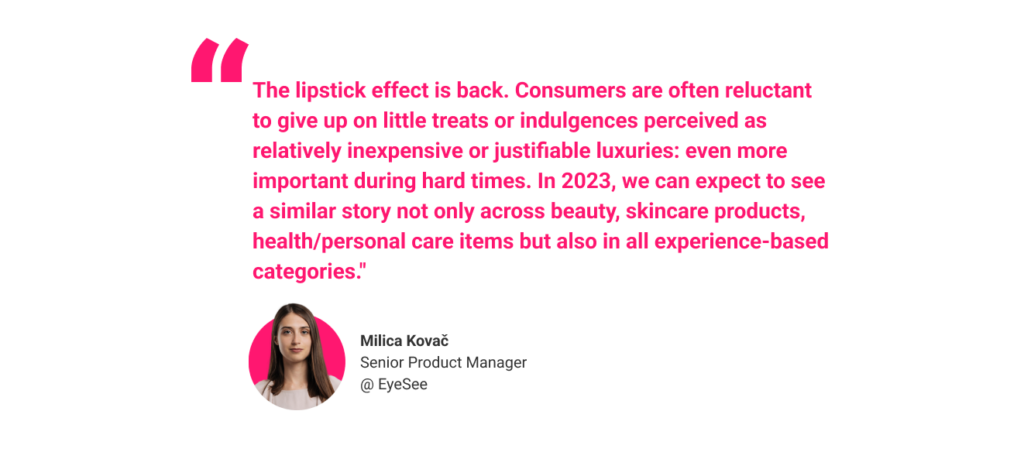2023 is around the corner and the pressure is tangible: so, how do you best adjust for the recession? While predicting the future is never an easy task, we’re firm believers that there’s no better way to brace yourself than to turn to behavioral know-how. Some of our top experts across departments and regions gathered to share:
- Insights, trends, and opportunities in shifting consumer behavior
- How to prioritize initiatives and what to avoid as a competitive brand
- Ways the MR industry is adapting to be more predictive and meet the needs of clients
We hope these perspectives serve as an inspiration to think beyond obvious challenges.
1. Drive actions with insight, not fear

During a crisis, when trends form and change much faster than usual, it is even more critical to both measure and launch new products that fit the needs of the consumer. With a steeper trend growth, it is essential to try harder to understand the current trends as the client’s needs are also developing faster. This means that the delta between the client’s requirement and the product offering is becoming even more significant – thus, the chance of switching brands grows higher if these needs are not fulfilled. Highly volatile environments (such as the recession) have much steeper trend curves – when that is taking place, it is imperative to monitor them with more research rather than stepping back until things settle.
2. Get to know the new kid on the block: 2023 Consumer

All the new pressures of this crisis have led to similar challenges brands had to make two years ago – shortages, supply chain issues, and, consequently, prioritization of product distribution. Due to this, brands had to make complex decisions in terms of trimming their portfolio, reducing pack sizes and counts, or shifting pricing at the same time. Relying on past data is simply not an option now when pricing sensitivity is fluctuating and consumer confidence is unstable. Although previous experiences with different recession periods showed us the various consumer reactions across categories – it is brands’ reactions and choices that are also changing the market landscape.
3. Avert switching through quality and exclusivity
Even when high inflationary pressures do not affect the everyday life of consumers, the biggest challenge brands must deal with is remaining competitive – especially with the growing penetration of private label brands. With the appealing prices combined with the on-par quality of shopper-favorite products, private label packs have been making their way into consumer carts more and more over the last years.

4. Consumers seek to treat themselves under pressure
But, do consumers recognize your product as indulging? Your pack and claims need to be tested on their shelf performance as 9 out of 10 packs are ineffective and don’t produce sales impact.

5. Blur the lines between online and brick-to-mortar
As gas prices reach record highs, so do the concerns about the cost of daily lives. The complex global environment is bound to have major effects on established shopping practices and the functions of touchpoints.

6. Tune your omnichannel voice
A smooth and seamless experience across touchpoints is now fully expected by consumers. Their standards are changing – and brands must keep in mind the hyper-sensitivity of their customers. Research shows that brand loyalties are the first to go as we adjust to the mounting pressures of the global recession.

7. Ride the wave of cashless payment and delivery alternatives
Driving value and meaningful connections across the Customer Experience is the top priority for many brands going into every new year – but what to expect in 2023? The key challenge will be finding just the right balance between the overall (and optimized) consumer journey and areas where you should step up on personalization to really bring that added value home. The truth is that the perception of what is valuable goes beyond price and is massively influenced by context; therefore, rethink and treat all in-store touchpoints as an opportunity.

8. Use videos… responsibly
Further, a clear-cut way to gain these learnings is by testing the video content in the right environment – be it YouTube, Meta, TikTok or any other platform.

Tools such as simulated social media feeds allow complete control over the testing environment and allow you to get more in-depth data on both engagement and brand impact.
9. Rethink research processes and data collection

The MR industry has massively transformed over the last 10-20 years in a way that alternatives are available at every turn – our team, for example, always finds ways to mix and match new methods and frameworks to meet the research questions and challenges.
10. Team up in crisis
The journey of successful co-branding begins with understanding the intersection of consumers and their behaviors. Pre-testing your advertising materials (online videos, TVC, social media posts, etc.) and packs can give you crucial insight into how consumers will see, react, evaluate, and if they would ultimately be inspired to purchase your co-branded product.

A mixed-method approach, where behavioral methods of eye tracking, facial coding and virtual shopping are combined with surveys, can measure such preferences with as much as an 80% correlation with actual shopping behavior.
Interested in more resources to help you navigate 2023? We’ve got you! Check out this selection of 10 recent behavioral studies.
